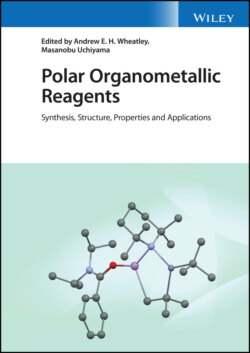Читать книгу Polar Organometallic Reagents - Группа авторов - Страница 24
1.4.4 Aluminates
ОглавлениеAromatic aluminium compounds are potentially attractive as functional materials and synthetic building blocks [200–202]. However, aromatic aluminium chemistry has not been well developed, mainly due to the lack of efficient preparative methods compatible with the presence of ancillary functional groups. A common synthetic route to aliphatic aluminium compounds is transmetalation of organolithiums or Grignard reagents to the corresponding aluminium compounds [203]. Unfortunately, these metalating reagents or the intermediary aromatic lithium or Grignard species they form are often too reactive to coexist with electrophilic functional groups like halogens, amides, nitriles, and π‐deficient heterocycles [12]. Neither insertion of aluminium into carbon–halogen bonds nor halogen–metal exchange reactions of aluminium on aromatic rings have been realized to date and this led to an interest in the development of new Al‐based ate reagents for effecting direct deprotometalation. Hence, a regio‐ and chemoselective direct alumination of functionalized aromatics using a newly designed aluminium ate base was investigated [204]. To develop this area, halogen–metal exchange and deprotonative metalation were both investigated. First, the halogen–aluminium exchange reactions of haloaromatics using various kinds of organoaluminum reagents were examined, but all attempts were unsuccessful. Then the deprotonative alumination of functionalized benzenes was investigated, a method which would be more advantageous to generate multifunctionalized aromatic aluminium compounds from the viewpoint of precursor availability. After extensive experiments using anisole and benzonitrile as model substrates, the complex lithium tri(isobutyl)(tetramethylpiperidido)aluminate i‐Bu3Al(TMP)Li 144, prepared by mixing i‐Bu3Al and LTMP in THF (Scheme 1.31) was found to be better than either Me3Al(TMP)Li 145 or Et3Al(TMP)Li 146 for achieving direct alumination under mild conditions (Scheme 1.32). The resulting aryl aluminate was treated with D2O or I2 to give the desired o‐dueterio‐ or o‐iodoanisole, respectively.
In the same way as the principles of structural chemistry have been applied to alkali metal zincates, allowing the interrogation of basic reagents and reaction intermediates and the development of an improved understanding of reaction processes, so have they helped elucidate the activity of aluminates. Four‐membered metallacycles akin to those reported for dialkylamidozincate bases are seen for trialkylamidoaluminates such as i‐Bu3Al(TMP)M(L) (M = Li, L = THF 147; M = Na, L = TMEDA 148; the crystal structure of the first is exemplified in Chapter 2, Figure 2.21) [205, 206], though a dialkyldiamidoaluminate has also been suggested, based on two metal‐bridging amides (see below) [207]. As with zincate chemistry, the alkali metal proved straightforwardly variable; though while Li and Na were relatively simple to work with [205, 206], K proved more problematic and required PMDETA as a stabilizing additive to prevent the TMP ligand from degrading [208]. As for zincates, reactivity was more complex and subtle than might at first have been expected. The polybasicity reported for zincates was not observed for 144, a fact rationalized theoretically in terms of the contrast between closed‐shell Al in a tetraorganoaluminate and 16 e− Zn in a triorganozincate [209]. Moreover, as spectroscopic studies have subsequently made clear, the heterobimetallic nature of isolated alkali metal aluminates belies the possibility of different reactive pathways. Instead of synergic reactivity and direct alumination of organic reagents, cooperative cleave‐and‐capture chemistry could occur whereby the deprotonative alkali metalation of an organic can instead precede the formation of an Al–C bond, so ‘capturing’ the reactive anion [93]. In either case, amide abstraction of a proton from the ortho position of the aromatic reagent is favoured. The intermediates expected for such processes were structurally modelled by sequentially treating ArC(O)Ni‐Pr2 with t‐BuLi and i‐Bu3Al in THF to obtain diffraction quality crystals of 149 (Figure 1.19). Their stability in solution was also studied, with partial desolvation observed in hydrocarbon media. In spite of this, exposure to excess HTMP failed (in accordance with theory) to affect the reaction (i.e. quenching of the amine) [209]. The complete passivity of either ortho‐aluminate towards HTMP has been further evidenced by 1H and 13C NMR spectroscopic analysis using (non‐polar) benzene or (Lewis basic) THF media and introducing excess amine by injection. In either solvent, chemical shifts attributable to ortho‐aluminate were unchanged upon addition of amine, even after heating to reflux.
Scheme 1.31 Synthesis of i‐Bu3Al(TMP)Li 144.
Scheme 1.32 Ortho‐alumination of a functionalized aromatic ring.
Figure 1.19 Model aluminate 149, obtained by sequentially treating ArC(O)Ni‐Pr2 with t‐BuLi and i‐Bu3Al in THF.
The synthetic utilization of kinetic basicity was a fundamental driver for developing the aluminate systems described here. This mode of action has been nicely demonstrated, albeit in a nonaromatic aside; regioselectively functionalizing unsymmetrical ketones. Methyl isopropyl ketone reacted with a mixture of i‐Bu3Al and LTMP at 0 °C in THF to selectively give the kinetic enolate with near complete selectivity. Subsequent electrophilic trapping with benzaldehyde then proceeded smoothly to give only the corresponding regioisomer. A range of other unsymmetrical acyclic and cyclic ketones then demonstrated similar kinetic regioselectivity in their functionalization, even under harsh conditions; heating to reflux in THF for 18 h [209]. In an example of interesting functional group tolerance by aluminates, use of the dialkyldiamidoaluminate [207] i‐Bu2Al(TMP)2Li 150 has enabled the highly efficient, facile conversion of 4‐halo‐anisoles to synthetically important triheterohalogenated anisoles (151–153) through the sequential reaction of a 4‐halo reagent with sulfuryl chloride, N‐bromosuccinimide and/or iodine (Scheme 1.33) [210]. Of course, the impressive compatibility of the base with halogenated reagents underpins this reactivity. This contrasts strongly with that of many traditional organometallics and it extended to the ability to isolate and fully elucidate ortho‐aluminated intermediates in both the first (154) and second (155) halogenation processes (Figure 1.20).
Scheme 1.33 i‐Bu2Al(TMP)2Li 150 has enabled the conversion of 4‐halo‐anisoles to triheterohalogenated anisoles 151–153.
Figure 1.20 Molecular structures of aluminated precursors 154 and 155 to (a) di‐, and (b) triheterohalogenated anisole derivatives, respectively.
Source: Adapted from Conway et al. [210].
Figure 1.21 Representation of the Gilman amidocuprate (TMP)2CuLi.
